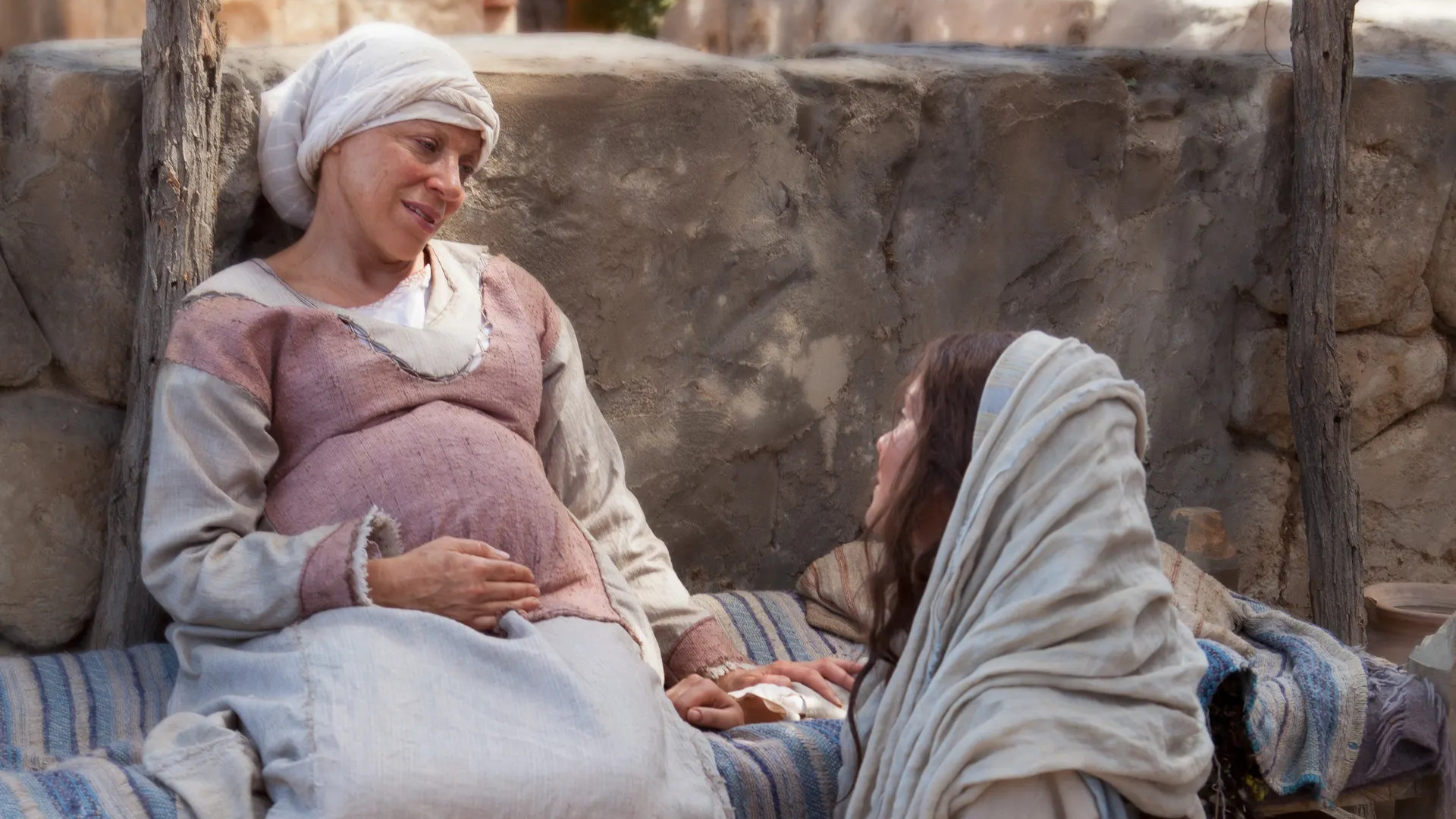You are here
Why are Childless Women Prominent in the Christmas Story?

Luke 1:7
The Know
Just as the Gospel of Luke begins with the account of the angel Gabriel’s appearance to the temple priest Zacharias, assuring him that his wife would yet bear him a son (Luke 1:13, 19), many stories of prominent women in the Old Testament—including the three great matriarchs Sarah, Rebekah, and Rachel—begin with a similar problem. Although each of them was barren (Genesis 11:29–30; 18:11; 25:20–21; 29:28, 31; Judges 13:2; 1 Samuel 1:1–2; 2 Kings 4:14), God’s promises and covenants would be kept through divine and joyous means. These stories of childlessness and miracle children were certainly not lost on Luke, a medical physician, who begins his account of Christ’s birth with another barren couple. Like Sarah and Abraham, Elisabeth and Zacharias were “well stricken in years” (Luke 1:5).
In spite of seeming impossibility, none of these faithful wives and husbands gave up hope that God would someway give them a child who would be a special servant of the Lord. In each of these cases, sacred promises and the temple were central to their faith and hope:
- Speaking of Sarah, Paul says, “Through faith also Sara herself received strength to conceive seed, and was delivered of a child when she was past age, because she judged him faithful who had promised.” (Hebrews 11:11).
- Joseph Smith explained, “Zachariah having no children, knew that the promise of God must fail, consequently he went into the Temple [sic] to wrestle with God according to the order of the preisthood [sic] to obtain a promise of a son.”1 Hannah also “went up to the house of the Lord” to pray for a son and vowed to consecrated him to the Lord if her desire was granted (1 Sam 1:7, 10–11).
- An angel appears to Sampson’s mother to declare that she would have a child and that she would need to consecrate him to the Lord. She and her husband interact with the angel again, make an offering at a temple altar, ask the visiting angel for his secret name, and declare that they had “seen God” (Judges 13:3–24).
Into this backdrop of temple-hope and miraculous births, Luke introduces the virgin, Mary. According to the little-known early Christian text, the Infancy Gospel (or Protevagelium) of James, Mary herself was a miracle child, born to an old, barren couple, Joachim and Anna. This text opens with Joachim making offerings in the temple, but he was asked by administrators to desist and leave because of his barrenness. He goes into the desert lamenting, ponders on the story of Abraham who was given a child in his old age, and fasts and prays for a child. Anna also laments and prays that God would bless her as he had blessed Sarah. An angel appears to both Joachim and Anna and tells them that they would indeed bear a child, and Anna vows that the child would be consecrated to the Lord. Joachim then goes to the temple to make offerings where this blessing is confirmed to him. They give birth to Mary, and at the age of three Mary, like Samuel, is dedicated to the temple and raised there until she began having her menstrual periods and was then espoused by the High Priest to marry a worker in the temple named Joseph (see Protevagelium of James 1:1–9).
As the story in Luke continues, Mary was soon visited by an angel who tells her she will bear a child even though she is a virgin. She thus goes from Nazareth to visit her aged cousin Elisabeth who, unbeknownst to Mary, was now pregnant with a child who would be John the Baptist. While in the presence of the surprisingly once-barren Elisabeth, Mary utters her poetic Magnificat—a psalm of praise that, as scholars have noted, echoes much of the terminology and phraseology of the joyful psalm of praise given by the once-barren Hannah in the Old Testament (Luke 1:26–55).2 Mary, no doubt, felt a kinship to these women who miraculously found themselves pregnant.
Hannah’s initial plea at the temple and her subsequent psalm of joy included lines echoed in Mary’s Magnificat: “O Lord of hosts, if thou wilt indeed look on the [a] affliction of thine handmaid, and [b] remember me, and not forget thine handmaid … [c] My heart rejoiceth in the Lord,… The bows of [d] the mighty men are broken, and they that stumble are girded with strength. …. [e] they that were hungry ceased … the barren hath born seven… He [f] raiseth up the poor out of the dust, and lifteth up the beggar from the dunghill, to set them among princes, and to make them inherit the throne of glory” (1 Sam 1:11, 2:1–8).
Mary’s words clearly echo those of Hannah: “[c] My soul doth magnify the Lord, And my spirit hath rejoiced in God my Saviour. For he hath regarded [a] the low estate of his handmaiden: for, behold, [b] from henceforth all generations shall call me blessed [she will not be forgotten]. … He hath [d] put down the mighty from their seats, and [f] exalted them of low degree. He hath [e] filled the hungry with good things; and the rich he hath sent empty away. He hath holpen [helped] his servant Israel, in remembrance of his mercy; As he spake to our fathers, to Abraham, and to his seed for ever” (Luke 1:46–55).
The Why
In temples and through the covenants associated with them, the Lord’s people in all ages received certain promises. Such promises were given to Adam and Eve when God gave them dominion (royal and priestly authority) over the earth (land) and commanded them to be fruitful and multiply (seed) in Genesis 1:26–28. These same promises were given to Abraham and many others when God gave them priesthood, land, and promised posterity as numerous as the stars (see, e.g., Genesis 12:1–3; Abraham 2:3–11; 1 Nephi 2:19–24). These same promises have been restored in our day (see D&C 132:19) and figure ultimately in the sealing ordinances of the temple. The Father’s great plan involves the coming forth of his children into this world, including the great and the small, the noble and even his Only Begotten.
To fulfill his purposes, God can direct and protect the birth of children, both “in time, and through all eternity” (D&C 132:19). The fact that the promises of God pertain not just to eternity but also to the mortal era is also taught in the Book of Mormon: “the promises which we have obtained are promises unto us according to the flesh. … That my covenants may be fulfilled which I have made unto the children of men, that I will do unto them while they are in the flesh” (2 Nephi 10:2, 15).
A belief that God’s promises were for “time” as well as eternity may have spurred the barren women and men to keep hoping and acting in such faith, even in the face of old age and seeming impossibilities. As Paul said that Sarah had faith to conceive “because she judged him faithful who had promised” (Heb 11:11), and as Joseph Smith said that “Zacharias … knew that the promise of God must fail” if he didn’t have a son, so the angel informed Mary concerning Elisabeth, “with God nothing is impossible” (see Luke 1:36–37). The miraculous pregnancies of these women were signs to all Israel and all the world that God can indeed fulfill his promises in time, as well as eternity.
As if to punctuate God’s full might and ability, Mary’s own pregnancy was an even greater miracle than the pregnancies of very old couples. Her Holy Child comes into the world in such a way as to be the sign (see Isaiah 7:14) that deliverance from all of sins, all of our lowly fallen states, has been given and that all the promises of God in temples will indeed be fulfilled in time, just as Mary’s first Christmas song declares. Through his covenant, God indeed lifts up the poor and beggars and makes them kings and queens; he protects his people from their enemies; and all who are barren, both literally and figuratively, will indeed bear fruit. And not just in eternity, but in this temporal and temporary world as well.
Exactly when or how he will fulfill his promises to each of us is not fully known and is an individual matter, but surely the Millennium will have something to do with it. That era is part of the “time” of mortality and is the appointed moment when Christ will restore all things, that his faithful followers can become kings and queens in the Father’s eternal kingdoms of glory, healed with resurrection’s power, and brings joy from every tear.
As the scriptures above testify, God works miracles among those who consistently act in faith, even before that eternal day, and even when the fulfillment of his covenantal promises seems impossible. At Christmas time we can be assured that, if God the Father can cause a virgin to conceive, then he is able to fulfill, both in time and eternity, every promise he has made, to all who follow his Son. With that assurance, we too can break forth in song with Isaiah and Jesus:
Sing, O barren, thou that didst not bear; break forth into singing, … For a small moment have I forsaken thee; but with great mercies will I gather thee. In a little wrath I hid my face from thee for a moment; but with everlasting kindness will I have mercy on thee, saith the Lord thy Redeemer. (Isaiah 54:1–8; quoted by Jesus in 3 Nephi 22:1)
Further Reading
S. Kent Brown, Mary and Elisabeth: Noble Daughters of God (American Fork, UT: Covenant Communications, 2002).
S. Kent Brown, The Testimony of Luke in Brigham Young University New Testament Commentary (Provo, UT: BYU Studies, 2015), 81–121.
Margaret Barker, Christmas: The Original Story (London, SPCK, 2008), 129–161.
Raymond E Brown, The Birth of the Messiah: A Commentary on the Infancy Narratives in Matthew and Luke (New York: Doubleday, 1977), 235–366.
- 1. Discourse, 23 July 1843, as Reported by James Burgess, p. 13, The Joseph Smith Papers, accessed December 4, 2023, https://www.josephsmithpapers.org/paper-summary/discourse-23-july-1843-a...?
- 2. See, for example, J. T. Forestell, “Old Testament Background of the Magnificat,” Marian Studies 12 (1961): 205–244. Some New Testament manuscripts indicate that it is Elisabeth who speaks the Magnificat likely due to the vocabulary being better applicable to barren women, not virginal, but this is not necessary as Raymond E. Brown, The Birth of the Messiah: A Commentary on the Infancy Narratives in Matthew and Luke (New York: Doubleday, 1977), 361 noted.
KnoWhy Citation
Related KnoWhys
Subscribe
Get the latest updates on Book of Mormon topics and research for free





